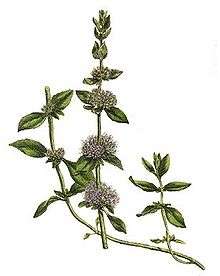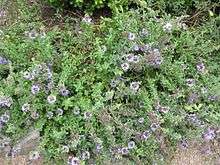Mentha pulegium
| Mentha pulegium | |
|---|---|
 | |
| Scientific classification | |
| Kingdom: | Plantae |
| (unranked): | Angiosperms |
| (unranked): | Eudicots |
| (unranked): | Asterids |
| Order: | Lamiales |
| Family: | Lamiaceae |
| Genus: | Mentha |
| Species: | M. pulegium |
| Binomial name | |
| Mentha pulegium L. | |
Mentha pulegium, commonly (European) pennyroyal, also called squaw mint, mosquito plant[1] and pudding grass,[2] is a species of flowering plant in the family Lamiaceae native to Europe, North Africa, and the Middle East.[3] Crushed pennyroyal leaves exhibit a very strong fragrance similar to spearmint. Pennyroyal is a traditional culinary herb, folk remedy, and abortifacient. The essential oil of pennyroyal is used in aromatherapy, and is also high in pulegone, a highly toxic volatile organic compound affecting liver and uterine function.
Culinary and medicinal uses
Pennyroyal was commonly used as a cooking herb by the Greeks and Romans. The ancient Greeks often flavored their wine with pennyroyal. A large number of the recipes in the Roman cookbook of Apicius call for the use of pennyroyal, often along with such herbs as lovage, oregano and coriander. Although it was commonly used for cooking in the Middle Ages, it gradually fell out of use as a culinary herb and is seldom used as such today. The fresh or dried leaves of the plant were used to flavor pudding.[4]
Even though pennyroyal oil is extremely poisonous, people have relied on the fresh and dried herb for centuries. Early settlers in colonial Virginia used dried pennyroyal to eradicate pests. Pennyroyal was such a popular herb that the Royal Society published an article on its use against rattlesnakes in the first volume of its Philosophical Transactions in 1665.[5]
Pennyroyal is used to make herbal teas, which, although not proven to be dangerous to healthy adults in small doses, is not recommended, due to its known toxicity to the liver.[6] Consumption can be fatal to infants and children.[6] It has been traditionally employed as an emmenagogue (menstrual flow stimulant) or as an abortifacient.[6] Pennyroyal is also used to settle an upset stomach[7] and to relieve flatulence.[8] The fresh or dried leaves of pennyroyal have also been used when treating colds, influenza, abdominal cramps, and to induce sweating,[7] as well as in the treatment of diseases such as smallpox and tuberculosis, and in promoting latent menstruation.[8] Pennyroyal leaves, both fresh and dried, are especially noted for repelling insects.[7] However, when treating infestations such as fleas, using the plant's essential oil should be avoided due to its toxicity to both humans and animals, even at extremely low levels.[9]
Toxicity

Pennyroyal essential oil should never be taken internally because it is highly toxic; even in small doses, consumption of the oil can result in death.[10] The metabolite menthofuran is thought to be the major toxic agent. Complications have been reported from attempts to use the oil for self-induced abortion. For example, in 1978, an 18-year-old pregnant woman from Denver, Colorado, died within one week after consuming one ounce of concentrated Pennyroyal oil in an attempt to self-induce abortion.[11] There are numerous studies that show the toxicity of pennyroyal oil to both humans and animals.[12][13][14][15]
Since the U.S. Congress passed the Dietary Supplement Health and Education Act in October 1994 all manufactured forms of pennyroyal in the United States have carried a warning label against its use by pregnant women, but pennyroyal is not regulated by the U.S. Food and Drug Administration.[16]
Attributed and possible contributions to death
- 1897- A 23-year-old British woman died eight days after swallowing a tablespoon of pennyroyal in order to induce menstruation.[10]
- circa 1909- The Supreme Court of Indiana convicted a Mr. Carter of prescribing and administering pennyroyal pills to a pregnant woman who died two months after her miscarriage.[17]
- August 1912- A 16-year-old girl from Maryland consumed 36 pennyroyal pills to induce abortion.[10] An autopsy revealed that the herbal abortion was only partially successful.[10]
- November 1978- An 18-year-old pregnant woman from Denver, Colorado, died after ingesting one ounce of concentrated pennyroyal oil in an effort to abort her fetus.[11] Prior to her death, the victim had reported using the dried leaves of the plant to induce menstruation with no ill effects.[11]
- July 1994- Kris Humphrey, a 24-year-old woman, died in California.[18] At the time of her death, Humphrey unknowingly had an ectopic pregnancy, and drank an herbal tea made with pennyroyal extract.[18] According to one news report, there is disagreement over whether Humphrey died as a result of the ectopic pregnancy or from pennyroyal poisoning.[18]

See also
- Hedeoma pulegioides (American Pennyroyal, a distantly related species)
References
- ↑ Gunby, Phil (1979). "Medical News: Plant Known for Centuries Still Causes Problems Today". Journal of the American Medical Association. 241 (21): 2246–2247. doi:10.1001/jama.241.21.2246.
- ↑ Keville, Kathi. (1994). Herbs: An Illustrated Encyclopedia. New York, New York: Friedman/Fairfax Publishers. Pp. 128.
- ↑ Kew World Checklist of Selected Plant Families
- ↑ M. G. Kains (1912). American Agriculturist, ed. Culinary Herbs: Their Cultivation Harvesting Curing and Uses (English). ORANGE JUDD COMPANY.
- ↑ "Of a Way of Killing Ratle-Snakes". Philosophical Transactions of the Royal Society of London. 1: 43. 1665. doi:10.1098/rstl.1665.0022.
- 1 2 3 French, Larry G. (October 2002). "Isolation of (R)-(+)-Pulegone from the European Pennyroyal Mint, Mentha Pulegium". The Chemical Educator. 7 (5): 270–277. doi:10.1007/s00897020599a.
- 1 2 3 Kowalchik, Claire, and William H. Hylton, eds. (1998). Rodale's Illustrated Encyclopedia of Herbs. Emmaus, Pennsylvania: Rodale Press. Pp. 412-414.
- 1 2 Ritchason, Jack. (1995). The Little Herb Encyclopedia: The Handbook of Natures Remedies for a Healthier Life. 3d ed. Pleasant Grove, Utah: Woodland Health Books. Pp. 171.
- ↑ "Warnings about Essential Oils". Bits and Brew. Archived from the original on 2008-04-23. Retrieved 2008-06-25.
- 1 2 3 4 Macht, David I. (1913). "The Action of So-Called Emmenagogue Oils on the Isolated Uterus with a Report of a Case of Pennyroyal Poisoning." Journal of the American Medical Association LXI(2):105-107.
- 1 2 3 Sullivan, John B. (28 December 1979). "Pennyroyal Oil Poisoning and Hepatotoxicity". JAMA: The Journal of the American Medical Association. 242 (26): 2873–2874. doi:10.1001/jama.1979.03300260043027. Retrieved 13 May 2015.
- ↑ Carmichael PG (February 1997). "Pennyroyal metabolites in human poisoning". Annals of Internal Medicine. 126 (3): 250–1. doi:10.7326/0003-4819-126-3-199702010-00016. PMID 9027280.
- ↑ Anderson IB, Mullen WH, Meeker JE, et al. (April 1996). "Pennyroyal toxicity: measurement of toxic metabolite levels in two cases and review of the literature". Annals of Internal Medicine. 124 (8): 726–34. doi:10.7326/0003-4819-124-8-199604150-00004. PMID 8633832.
- ↑ Bakerink JA, Gospe SM, Dimand RJ, Eldridge MW (November 1996). "Multiple organ failure after ingestion of pennyroyal oil from herbal tea in two infants". Pediatrics. 98 (5): 944–7. PMID 8909490.
- ↑ Sudekum M, Poppenga RH, Raju N, Braselton WE (March 1992). "Pennyroyal oil toxicosis in a dog". Journal of the American Veterinary Medical Association. 200 (6): 817–8. PMID 1568929.
- ↑ Natural Standard Research Collaboration (2008-02-01). "American pennyroyal (Hedeoma pulegioides L.), European pennyroyal (Mentha pulegium L.)". Natural Standard. Retrieved 2008-06-25.
- ↑ Editorial. (1909). "Medicolegal: Pyemia, "Pennyroyal Pills" and Evidence in Abortion Case. Journal of the American Medical Association LIII(11): 891.
- 1 2 3 Young, Gordon. (1995). "Lifestyle on Trial." Metro: Silicon Valley's Weekly Newspaper.
External links
| Wikimedia Commons has media related to Mentha pulegium. |
![]() Chisholm, Hugh, ed. (1911). "Pennyroyal". Encyclopædia Britannica (11th ed.). Cambridge University Press.
Chisholm, Hugh, ed. (1911). "Pennyroyal". Encyclopædia Britannica (11th ed.). Cambridge University Press.